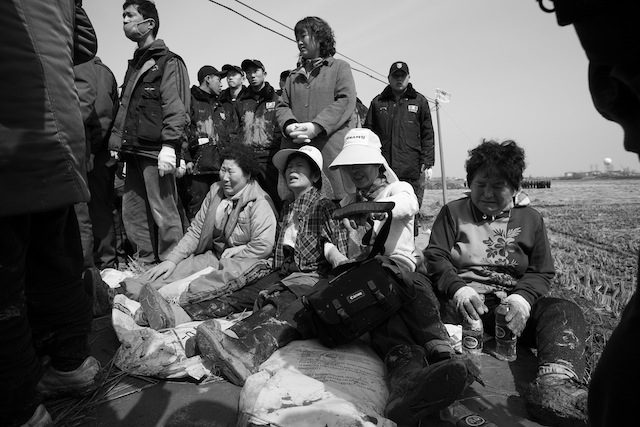Institute of Contemporary Arts Singapore, Lasalle College of the Arts, 11 February – 12 April
It is one thing to plan what flattering photo will be used at your own funeral, but another altogether to stage that funeral preemptively and then photograph the event. But that is precisely what a man from Kerala did in artist Anup Mathew Thomas’s gloriously inauspicious Staging at Nedumbarakkadu (2012), which is a photograph of a photograph. The original picture shows a man lying in an open coffin with two mourners sitting next to him. The accompanying text informs that this isn’t an actual funeral service but a full-dress rehearsal that occurred three years before the actual event. Featuring a garlanded casket, lit candles and his wife and father as extras, this arresting image not only investigates the ceremonial theatrics of death rites, but also the agency of the subject in controlling the nature and image of his memorialisation.
The power of art to ‘fix’ certain events and influence public memory is a recurring theme in Native Revisions, a group show of four Asian photographers – Thomas (India), Tomoko Yoneda (Japan), Chua Chye Teck (Singapore) and Noh Suntag (South Korea). The exhibition seeks, according to curator Melanie Pocock, to ‘reflect on the dynamics of return and its influence on our perception of places’. Although she wants to explore the artists’ ‘personal stakes in places’, some works remain stubbornly impersonal and blandly documentarian in character. These include Chua’s fetching but boring black-and-white photographs of tangled vines representing Singapore’s last forested frontiers (Beyond wilderness, 2014–16) and Thomas’s other photojournalistic works, such as that depicting the funeral of a bishop from a Syrian Christian church in Kerala (Scene from a wake, 2016).
Although the original subject matter of each photograph may risk erasure, something else slyer, more slippery and compelling takes its place
The exhibition is at its strongest when it moves away from an earnest but airless exploration of how photography can capture hidden histories of various locales, and becomes more self-reflexive. This is when the artists grapple with the medium’s limitations – its subjectivity, its indexicality – even as they exploit them for their own purposes. Formally assured while being fully aware of their own constraints, the most compelling pictures draw the viewer in while initiating her into their own inadequacy. Although the original subject matter of each photograph may risk erasure, something else slyer, more slippery and compelling takes its place.
One of the concepts Native Revisions explores is memorialisation, a process to which images are key. If Staging at Nedumbarakkadu highlights how memorialisation can be performative, Yoneda’s work expands on this idea. In The 70th 6 August, Hiroshima (2015), she is preoccupied less with the object of memorialisation and more with the act of memorialisation. Her wide-angle shot shows the annual peace service to commemorate the nuclear bombing of Hiroshima during the Second World War, a stately occasion with large white tents for spectators. But hers is a blurry image – the edges of the tents are furred, the two people in the centre aisle are translucent and ghostly. This fuzziness is the result of Yoneda’s superimposition of three negatives of the ceremony. The hazy, layered effect recalls a neuroscientific fact about how people form memories – by remembering the last memory and not the source event – and one can imagine this image imprinted on the collective consciousness 70 times over but getting no closer to the original trauma. And of the actual 6 August 1945, the photograph maintains an ambiguous silence.
Another creative framing of historical conflict can be seen in Noh’s monochrome series The strAnge ball (2004–7), in which a mysterious white sphere lurks in the background of several rural landscapes. The photographs were taken in the village of Daechuri in southwest Korea, where local farmers were fighting eviction by the South Korean government because the US wanted to extend its military base in the area. First trained as a news reporter before becoming an artist, Noh told The Korean Times in 2015 that he ‘was attracted to the wicked side of pictures’. This wickedness – or a certain impish amorality – can be seen in the ambiguous recurring motif of the white ball in what could have been straightforwardly political pictures. Actually a waterproof enclosure for radar equipment owned by the US, the ball appears over and over, whether as a tiny orb in the distance behind weeping farmers, or glimpsed between tree branches like a moon. Is it a UFO? A surveilling eyeball? A cystic representation of American influence? Shapeshifting and hard to pin down, this ball could well stand in for the complex presence of the photographer himself, as a persistent but shadowy sort of witness with unknowable aims.
First published in the Summer 2017 issue of ArtReview Asia
